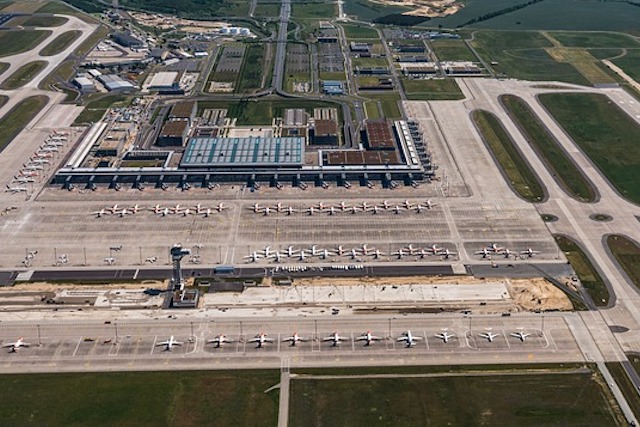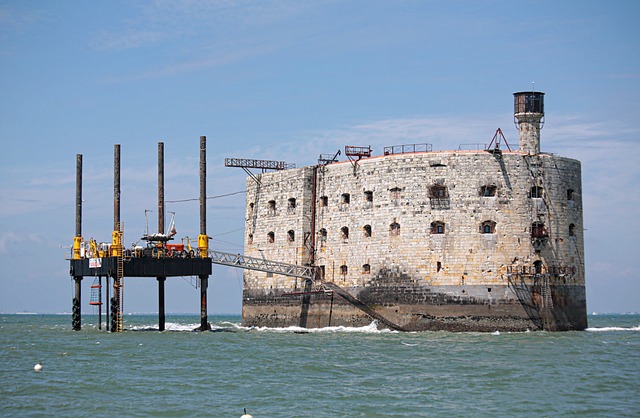Every summer, cities around the world begin construction projects that cause detours and gridlock and seem to last for weeks or even months. They can be noisy, frustrating, and an eyesore until they’re finished. And they’re also a breeze compared to some of these projects that have taken decades. Or longer.
10. The Corinth Canal was proposed over 2,000 years ago

The Corinth Canal occupies an unusual place in the history of construction projects. In theory, it’s one of the oldest, though in practice it’s not as long as some others. Not that it was fast, the entire project took 11 years from its start in 1882 to its completion in 1893. That’s a long time to build anything. But when you learn that the canal was even proposed by Emperor Nero, you can appreciate how long this thing has been in the works.
The canal connects the Gulf of Corinth with the Saronic Gulf and has length just under 6.4 km or 4 miles . The width is 25 meters or 82 feet. Before its construction, the route from point A to point B that it connects would take ships another 185 nautical miles to go around the Peloponnese.
The idea of the canal belongs to Periander, known as the Tyrant of Corinth, in 602 BC Others had the idea, including Julius Caesar and Caligula, but they were warned that the Adriatic would drain into the Aegean Sea if they went through with it, so they abandoned it. It wasn’t until 67 AD that Nero made an attempt, gathering 6,000 slaves and devising a plan to make it happen. Unfortunately for him, he was assassinated before the project could begin. It was about 1,800 years before construction really got underway.
9. It took between 20,000 and 100,000 people 20 years to build the Great Pyramid.

The pyramids of Egypt have fascinated people all over the world for literally centuries. There are still people who think they must have been built by aliens, or at least under their supervision. Why? Because the idea of ancient people doing anything on their own is apparently a mystery. Go figure. But we have pretty good evidence that real earthlings built them, and how long it took them to do so.
There is currently no precise information about the construction of the pyramids, but it is currently believed that the Great Pyramid took about 20 years between 2560 BC to 2540 BC , give or take a little. Herodotus, the Greek historian, claimed it took 100,000 men over 20 years, but he was known to be a bit flowery in his stories and make claims that weren't really backed up by any evidence. More modern guesses suggest 20 years was right, but it was closer to 20,000 people . Which, you know, is a lot. For what it's worth, it's also believed that hired laborers, not slaves, also built the pyramids.
Sphinx was estimated to be something of a faster job, taking 100 workers to complete. about three years .
8. The German airport took 14 years to build.

Airports in major cities around the world are becoming increasingly complex and can take months or even years to build. Construction of New York's John F. Kennedy Airport, one of the country's largest and busiest, started in 1943 and did not end until 1948, although with a three-year delay.
Airport Berlin-Brandenburg in Germany could be the longest-running airport construction project at 14 years. That was the total time between breaking ground and when they finally had to start work. It also happened through 30 years old after the initial proposal for the airport and 9 years after it was supposed to be completed.
The planning process took years and years, and once construction began, more problems arose. The company in charge of planning the construction filed for bankruptcy. Then safety issues delayed the opening. They continued after the next opening date, so it was delayed again. Then the airport's technical director was accused of bribery, and other board members quit. Then they found out that the guy in charge of all those faulty safety features had falsified his credentials. His explanation? "Everyone thought I was an engineer. I just went along with it."
The circus of failures continued when the next CEO was fired after the previous one left. More allegations of bribery and corruption emerged, and finally, in 2020, he was given the green light to open.
7. The Ryugyong Hotel in North Korea has been under construction since 1987.
What's the hottest hotel in all of North Korea? If you said "Ryugyong Hotel," you're right! Sort of, sort of. Obviously, North Korea isn't exactly a popular vacation spot, but that doesn't mean they haven't been doing things like building a luxury hotel for 35 years.
Construction of the massive glass pyramid-like structure began in 1987. It was supposed to rise 1,000 feet or 300 meters, have 3,000 rooms and not one but 5 revolving restaurants so you never had to turn over during any meal. It was supposed to open by 1989. It missed that target by a bit.
They finally reached that 1,000 feet in 1992. It just didn't have any windows yet. It stayed that way for the next 16 years. People started calling it the Hotel of Destiny, because why not? By 2019, it had windows and even LED lights, and was known as the tallest unoccupied building in the world. At one point, it was estimated that it accounted for 2% of the country's entire GDP, or about 750 million US dollars .
It is believed that part of the reason it is not in use is that the structure is made entirely of concrete rather than steel, so fitting it with all the wiring and plumbing is a much more difficult task. There are also rumours that it may have been built incorrectly.
6. Fort Boyard was begun in 1804 but was not completed until 1857.

Head to the west coast of France and you will find the island of Aix and the island of Oléron. In between you will also find Fort Boyard , a former military base and game show setting much later in its history.
Louis XIV was the first to want to build a fort here. He was told it would be easier catch the moon with your teeth , than to build there. So Napoleon had to start building many years later with plans in 1801, and then building in 1804. And then the Battle of Aix-la-Rouds stopped it for as many as 30 years .
By 1842, the plans were back on track, and by 1857 it was ready to go. The problem by then was that artillery had advanced so far that the guns could fire across the entire distance between the two islands and ignore the fort entirely. By the time it was finished, it was useless.
5. The New York City subway on 2nd Avenue was planned in 1920 but is still not completed.
The New York City subway system is pretty famous, and even if you've never been to the city, it's been featured so much in movies and films that millions of people around the world have seen it to a greater or lesser degree. But what none of us have ever seen is the 2nd Avenue subway, a project that's been in the planning or construction stages since the 1920s and seems like it will never get built.
The idea of a subway on 2nd Avenue was proposed back in 1920 city engineer. In 1929 it was again proposed by the transport authority By the 1940s, they had removed the elevated train and, you guessed it, proposed replacing it with a subway on 2nd Avenue. The war delayed the plan again.
The real progress came in the 1950s when a bond was passed that gave the city $500 million to build the line. But instead they just use the money on existing subway lines. In 1968 They planned to build it again with new money. And then, in 1972, they actually broke ground, this time for real, on the 2nd Avenue line. But the city ran out of money, and the project was stopped. It wouldn't start moving again until 2007.
By 2017, part of the metro was actually completed and opened to the public. Three more stages of construction are planned, but these are only plans for now. How long might this take?
4. Sagrada Familia has been under construction for over 135 years.
Cathedrals, as we shall see in a moment, are not easy to build. They span generations and entire architectural movements, and they are extremely expensive, not to mention that they are often stopped by things like wars.
The Sagrada Familia in Barcelona was designed in 1882, with the cornerstone laid in March of that year. Construction continued in parts, with things like the bell tower being completed in 1925. Vandalism caused a setback in 1936, but things soon returned to normal.
The finished church is expected to be huge, with plans to include space for 13,000 people . But it has not yet been done, and the original project was expected to take at least 200 years. In 1984, it was declared a UNESCO World Heritage Site.
3. Milan Cathedral was continuously built for almost 600 years.
As far as we can tell, construction of the Milan Duomo began as early as 1386. It was to be another of the impressive and stunning Gothic cathedrals at the height of the architectural style's popularity.
By 1418 the Pope came to consecrate the altar, and by the end of that century even Leonardo da Vinci had a hand in the project. Construction on the inside continued steadily, albeit slowly, and during Napoleon's reign much of the façade and spires were in place on the outside, although it was not yet finished. In fact, with additional repairs, glazing and additional work on the façade, the cathedral was not finished. until 1965 , a full 578 years after it began.
2. Cologne Cathedral took 632 years to build.
As we have seen, building a cathedral is a serious matter. Cologne Cathedral is already 632 years old, and the cornerstone was laid in 1248 The project hit a snag in the 16th century when the city ran out of money and Gothic architecture seemed outdated, so they stopped for 300 years.
By the 1800s, King Frederick William IV of Prussia decided that completing the cathedral would be a good idea, so it was funded by donations and finally completed in 1880 .
1. It took about 2,300 years to build the Great Wall of China.

The Great Wall of China is a marvel of engineering that stretches at 13,000 miles or about 21,000 km . Parts of the wall date back to the 5th century BC, and the Chu Square Wall dates back to 7th century BC Because it connected many pre-existing walls and fortifications, it was never actually a single building project, but Qin Shin, the first emperor of China, began connecting many of these walls together in the third century BC.
Many of these early segments of the wall no longer exist, but construction continued for centuries. Many of the most famous segments today were built during the Ming Dynasty, from the 14th to 17th centuries. In total, the wall survived nine Chinese dynasties and took about 2300 years .













Оставить Комментарий